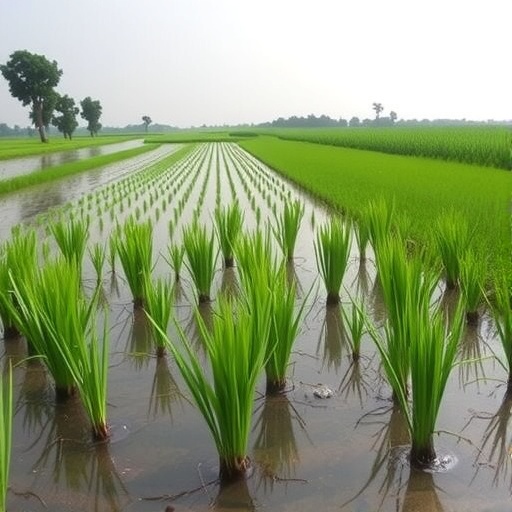In a groundbreaking study published in the journal Discover Agriculture, researchers, led by A.L. Caetano et al., investigated the intricate physiological, anatomical, and growth traits of drought and flooding-tolerant rice genotypes subjected to water stress. Understanding how rice plants adapt to varying water availability could pave the way for innovative agricultural practices, promoting food security in the face of climate change. This study not only uncovers the mechanisms by which these rice varieties thrive under stressful conditions but also offers invaluable insights into potential enhancements for crop resilience.
The cultivation of rice, a staple food for more than half of the world’s population, is increasingly threatened by unpredictable climatic phenomena, including drought and excessive flooding. For regions heavily reliant on rice cultivation, ensuring that crops can withstand such extremes is critical. The researchers focused on the unique adaptations of different rice genotypes, revealing how these plants cope with contrasting water conditions. This work builds upon previous findings regarding the physiological traits that confer resistance to water extremes, offering a deeper understanding of aerenchyma formation and gas exchange.
Aerenchyma, specialized tissue developed in response to excess moisture or drought, plays a crucial role in the survival of rice plants during water stress. This tissue allows for improved gas exchange, critical for maintaining cellular respiration while managing water levels. The study meticulously analyzed the formation of aerenchyma across various rice genotypes, measuring the structural development and its associated impacts on plant growth and efficiency. Insights gained from this research could lead to genetic breeding strategies aimed at enhancing these traits in widely cultivated rice varieties.
Gas exchange rates are another focal point of the study. The researchers employed sophisticated tools and methodologies to measure carbon dioxide (CO2) exchange, revealing significant variations among the rice genotypes tested. These differences manifest not only in the efficiency of photosynthesis but also in the plants’ ability to cope with diverse water regimes. Enhanced gas exchange can drastically influence growth rates, yield potential, and quality of the harvested grain. Therefore, the analysis of these traits is critical for breeding programs aimed at developing resilient rice varieties.
The anatomical traits of leaves and roots are also pivotal components of this study. By examining leaf morphology and root structure, the researchers identified physical adaptations that enable these crops to tolerate both drought and flooding. For instance, deeper root systems can access water buried deeper in the soil, while broader leaf structures may enhance evaporation under humid conditions. Understanding these characteristics allows for a more holistic approach to agricultural breeding, moving beyond just yield and pest resistance to encompass water management and stress tolerance.
Ultimately, the interplay between aerenchyma formation, gas exchange, and growth traits provides a multifaceted view of how rice plants respond to environmental stressors. The findings indicate that some genotypes exhibit superior adaptability, making them prime candidates for further research and future agricultural applications. The implications of this work extend well beyond academic interest; they address pressing global issues regarding food production and sustainability.
Moreover, the study emphasizes the importance of employing a comprehensive approach to plant breeding. Traditional methods have often focused primarily on yield, but the increasing extremities of climate exemplify the need for a broader set of selection criteria. Integrating traits that confer resilience to both drought and flooding can ultimately lead to more sustainable farming practices, ensuring consistent food production in the face of unpredictable environmental challenges.
In a world that is becoming increasingly aware of the impacts of climate change, the search for robust rice varieties capable of thriving under adverse conditions has never been more urgent. This research not only advances our understanding of the biological underpinnings of drought and flooding tolerance in rice but also serves as a springboard for future innovations in crop genetics. By identifying and promoting these desirable traits, scientists can help agriculturalists secure food resources for growing populations, thus bridging the gap between ecological sustainability and agricultural productivity.
As the implications of this pioneering research are manifold, their execution holds various potential pathways to achieving reduced reliance on chemical inputs and increased adaptive capacities in the field. Managing the resulting impacts on local ecosystems and farming communities enhances the chances for success. Therefore, the future of agriculture may depend on how well the scientific community can leverage findings like these to make informed decisions that consider social, environmental, and economic factors.
The expansive reach of this study highlights the critical need for multi-disciplinary approaches combining agronomy, genetics, and environmental science. As climate patterns continue to evolve, so too must our strategies for cultivating staple crops like rice. This research is a promising step toward that goal, providing not just theoretical knowledge but also practical frameworks for implementing these findings into real-world scenarios.
In conclusion, the work by A.L. Caetano and colleagues offers significant insights into the resilience of rice genotypes under varying water stress conditions. Their investigation of aerenchyma, gas exchange, and anatomical characteristics leads to important considerations for the future of rice cultivation. As we face the challenges presented by climate change, the need for adaptive and resilient agricultural methods becomes increasingly paramount. Continued research in this field will undoubtedly pave the way for innovative solutions that can ensure global food security in unpredictable climates.
Subject of Research: Adaptations of drought and flooding-tolerant rice genotypes under water stress.
Article Title: Aerenchyma, gas exchange, growth, leaf and root anatomical traits of drought and flooding-tolerant rice genotypes under water stress.
Article References:
Caetano, A.L., de Pádua, M.P., dos Reis, C.H.G. et al. Aerenchyma, gas exchange, growth, leaf and root anatomical traits of drought and flooding-tolerant rice genotypes under water stress.
Discov Agric 3, 97 (2025). https://doi.org/10.1007/s44279-025-00270-z
Image Credits: AI Generated
DOI: 10.1007/s44279-025-00270-z
Keywords: aerenchyma, gas exchange, drought tolerance, flooding tolerance, rice genotypes, water stress, agricultural research, crop resilience.




